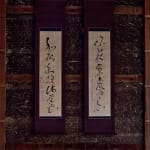Ryōkan (1758–1831)
Words from a Zen Poem
Ink on paper, pair of hanging scrolls
111 x 28 cm each
176 x 39 cm each (overall)
111 x 28 cm each
176 x 39 cm each (overall)
Exhibitions
Exhibition of Ryokan: 150 Years After His Death. Tokyo: Mitsukoshi Museum of Art; Osaka: Osaka Mitsukoshi, 1980.Ryokan-san: 170 Years After His Death. Kyoto: The Museum of Kyoto; Tokyo: Bunkamura The Museum, 2000–2001.
Literature
Ryokan. Tokyo: Chikumashobo, 1960.Calligraphy of Ryokan. Vol. 2. Tokyo: Daishukan Shoten, 1974.
Ryokan bokuseki taikan. Vol. 2: Kanshi-hen. Tokyo: Chuokoron Bijutsu Shuppan, 1994.
and others
In this pair of hanging scrolls, Ryokan renders two lines of a Chinese poem composed by Nan’ei Kenshu (1387–1460), a priest of the Soto school of Zen Buddhism who lived in the Muromachi period. The scrolls read:
At night, wind and rain was roaring outside the window
When dawn breaks, the flowers of the aronia tree have fallen
They are both signed, which is not common for pairs of scrolls, but perhaps the artist wanted to attend to the possibility of displaying them one by one. These scrolls have been previously included in various exhibitions and catalogs and may be considered a fairly well-known work.
Nan’ei Kenshu was a native of Satsuma who was a disciple of Daigaku Shusu of the temple Shokokuji in Kyoto. Thereafter, he studied Zen with Baizan Monpon and Sekioku Shinryo, and later stayed with the Soto priest Ketsudo Nosho of Kounji (Echigo Province) as part of an extended pilgrimage that lasted for thirteen years and concluded with Nan’ei becoming Ketsudo’s spiritual heir. In 1446, Nan’ei founded the temple Shugetsuji in Echigo.
Nan’ei dedicated the following verses to his teacher Ketsudo, which were later included in Jichiiki tojo shosoden, an anthology of anecdotes and recollections about notable priests of the Soto school in Japan:
Misunderstanding the nature of the dharmakaya, I saw not the dragon but a snake
Right in front of my eyes was that which should have pierced my heart
And at night in spring, wind and rain was pounding the eaves
When dawn broke the flowers of the aronia trees had fallen
The final two lines, chosen by Ryokan for the present two scrolls, represent the attainment of enlightenment after a long struggle. He replaces some of the words and characters from the original poem with more common variants, without changing the overall meaning, which was perhaps done to add a final polishing touch to the composition. The character kyu could also be read as aku (as in the original poem), yet this would imply the somewhat clumsy usage of Chinese poetry occasionally found among Japanese poets writing in Chinese, which is likely why Ryokan changed it.
His brushwork exhibits a beautiful flow, blending lines and characters in a manner that resembles the branches of a willow tree moving along in a gentle spring breeze.
Ryokan (Zen priest, poet; 1758–1831)
Zen priest, poet, and calligrapher of the Mid-Edo period. Born in Echigo Province (now Niigata Prefecture), Ryokan trained as a monk at Koshoji temple in his home province, and later at Entsuji in Bitchu (now Okayama Prefecture). Leading an itinerant life for many decades, Ryokan counted as a something of an eccentric even for Zen standards, yet his contributions to waka (Japanese-style) poetry and calligraphy remains highly regarded.
At night, wind and rain was roaring outside the window
When dawn breaks, the flowers of the aronia tree have fallen
They are both signed, which is not common for pairs of scrolls, but perhaps the artist wanted to attend to the possibility of displaying them one by one. These scrolls have been previously included in various exhibitions and catalogs and may be considered a fairly well-known work.
Nan’ei Kenshu was a native of Satsuma who was a disciple of Daigaku Shusu of the temple Shokokuji in Kyoto. Thereafter, he studied Zen with Baizan Monpon and Sekioku Shinryo, and later stayed with the Soto priest Ketsudo Nosho of Kounji (Echigo Province) as part of an extended pilgrimage that lasted for thirteen years and concluded with Nan’ei becoming Ketsudo’s spiritual heir. In 1446, Nan’ei founded the temple Shugetsuji in Echigo.
Nan’ei dedicated the following verses to his teacher Ketsudo, which were later included in Jichiiki tojo shosoden, an anthology of anecdotes and recollections about notable priests of the Soto school in Japan:
Misunderstanding the nature of the dharmakaya, I saw not the dragon but a snake
Right in front of my eyes was that which should have pierced my heart
And at night in spring, wind and rain was pounding the eaves
When dawn broke the flowers of the aronia trees had fallen
The final two lines, chosen by Ryokan for the present two scrolls, represent the attainment of enlightenment after a long struggle. He replaces some of the words and characters from the original poem with more common variants, without changing the overall meaning, which was perhaps done to add a final polishing touch to the composition. The character kyu could also be read as aku (as in the original poem), yet this would imply the somewhat clumsy usage of Chinese poetry occasionally found among Japanese poets writing in Chinese, which is likely why Ryokan changed it.
His brushwork exhibits a beautiful flow, blending lines and characters in a manner that resembles the branches of a willow tree moving along in a gentle spring breeze.
Ryokan (Zen priest, poet; 1758–1831)
Zen priest, poet, and calligrapher of the Mid-Edo period. Born in Echigo Province (now Niigata Prefecture), Ryokan trained as a monk at Koshoji temple in his home province, and later at Entsuji in Bitchu (now Okayama Prefecture). Leading an itinerant life for many decades, Ryokan counted as a something of an eccentric even for Zen standards, yet his contributions to waka (Japanese-style) poetry and calligraphy remains highly regarded.



